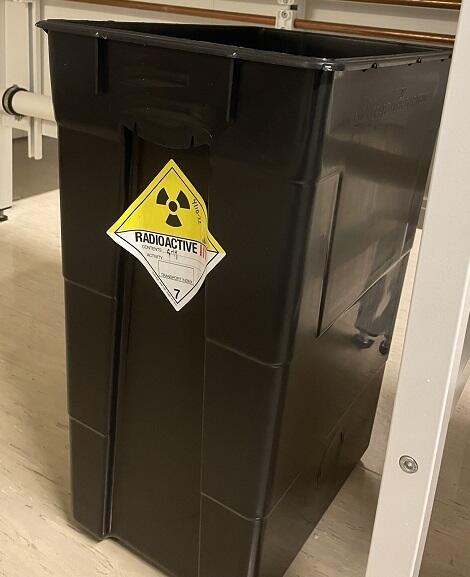Radioactive waste
Ionising radiation sources must be disposed of in varying ways depending on the type of radiation source.
Main content
Waste that comes under radioactive waste must be handled in accordance with the Guidelines for the handling and disposal of hazardous waste and problematic waste, radioactive waste and explosive waste and the routines described below.
The user is responsible for handling and disposing of the waste in a safe and correct way, taking into account the type of ionising radiation source.
New routines for disposal of hazardous waste, including radioactive waste has been implemented at UiB. These routines requires registration of waste in electronic disposal form at UiB, and registration in "Avfallsdeklarering.no". Only persons responsible for wast has access to "Avfallsdeklarering.no".
Waste containers for radioactive waste
All radioactive waste must be placed in black waste containers that are clearly marked with sticker for radioactive waste with a sticker for radioactive content on both the front and back. See picture of black waste container on the right side.
Declaration of waste and classification for transport
Open radiation sources
Regarding the disposal of open radiation sources, they are handled differently depending on the activity level and half-life(s) of the nuclide(s) used. The user is responsible for ensuring that the waste is handled in a proper and correct manner according to the radiation level of the waste.
Waste with activity level below the exemption limit
These are nuclides where the activity is not subject to declaration according to the "Regulations on the application of the Pollution Control Act to radioactive pollution and radioactive waste" (NO only) and which cannot obtain background radiation at decay within 1 year.
Waste with activity level above the exemption limit
Encapsulate radiation sources
Encapsulated radiation sources should preferably be returned to the supplier or to the Institute for Energy Technology (IFE), Kjeller.
X-ray tubes
Defective x-ray tubes are not to be regarded as radioactive waste, as x-rays can only be obtained by connecting to the electrical power grid. But because the pipe contains metal, including beryllium, which is a highly toxic light metal, the pipe is defined as hazardous waste, waste number 7086.
X-ray tubes must be secured against someone accidentally connecting the tube to the electrical system and declaring it as hazardous waste.

